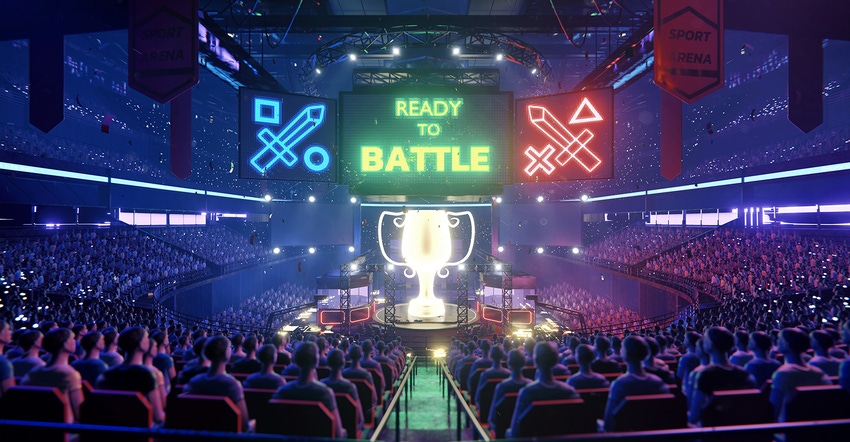As esport gaming continues to rise, so does the market of nootropic supplements as they have shown promise in enhancing brain function.

Insider Takes
Nootropics may enhance brain function, but not all ingredients with these properties are acceptable for use in supplements.
Racetams—synthetic substances developed as nootropic drugs—are causing confusion in the U.S. marketplace.
The rampant use of nonprescribed pharmaceutical nootropics in esports prompted development of league drug-testing.
Esports gaming is on the rise, as are nootropic supplements—or brain enhancers—that feed the players. A battle is raging in the nootropic supplement realm between pharmaceutical nootropics that often are of Eastern European or Asian origin, and those that are legitimate natural product ingredients.
In the Counter-Strike video games, terrorists battle counter-terrorists. In the nootropics realm, pharmaceutical nootropics like racetams, modafinil, tianeptine and noopept take on legitimate dietary supplement ingredients like ashwagandha, Bacopa monnieri, lion’s mane mushroom, phosphatidylserine, Ginkgo biloba and more.
What is a nootropic? Well, it stems from the Greek words noo (mind) and troppo (to turn or change), as noted by Vince Cakic, a researcher from the University of Sydney's school of psychology. Cakic called for testing on smart drugs like selegeline, modafinil and piracetam in 2009, pointing out, “Some of the drugs had well-known side effects, including addictive qualities and the potential to aggravate mental illness; it was unclear how dangerous most of them were for healthy people long term.”
An article published by Cakic in the Journal of Medical Ethics in October 2009 reviewed “the ethical and pragmatic implications of nootropic use in academia by drawing parallels with issues relevant to the drugs in sport debate.” He wrote, “It remains to be seen whether nootropics represent a pharmacological 'free lunch' or if the enhancement of some cognitive functions can only be realized at the expense of others.''
A 2018 Forbes article counted 165 million esports enthusiasts, with revenues for competitive gaming slated to hit US$1.65 billion by 2021. The most valuable esports franchise came in at $310 million, on par with some traditional professional sport teams. The market value of the nootropics supplement sector was approximately US$2.17 billion in 2018, with a predicted increase to $4.94 billion by 2025, according to Grand View Research. Big money is at stake both in competition and sales of products to esports gamers.
Drugs vs. supplements
Esports competitors have not been shy about the use of nootropic drugs like Adderall. Kory Friesen, aka “Semphis,” a professional Counter-Strike: Global Offensive player in the Electronic Sport League (ESL), frankly admitted to using Adderall in March 2015 during a video interview with BOXR posted on YouTube July 12, 2015. "We were all on Adderall. I don't even give a ****. It was pretty obvious if you listened to the comms. People can hate it or whatever.” The video has more than 330,000 views. The ESL announced it would create a drug-testing policy shortly after the interview.
Adderall is a combination of amphetamine and dextroamphetamine used in the treatment of attention deficit hyperactivity disorder (ADHD) and narcolepsy. Adderall is clearly a drug, classified by DEA as a Class II controlled substance. Amphetamine is included in the World Anti-Doping Agency (WADA) Prohibited List in category S6 Stimulants, which is now reportedly relevant in the ESL. So Adderall would be prohibited unless someone had a prescription for it.
When it comes to pharmaceutical nootropics from Eastern Europe or Asia, the lines are fuzzy as these substances are not FDA-approved drugs or controlled substances. Many are not listed as prohibited by WADA or other groups, although they could be interpreted as banned under the catchall language that includes “other substances with a similar chemical structure or similar biological effect.”
The difference between pharmaceutical nootropics and supplements may not always be apparent, but it should be considered by consumers and brands interested in using or making nootropic dietary supplements. Competitive gamers may risk careers by taking the wrong product. Meanwhile, some pharmaceutical nootropics may expose naïve consumers to serious adverse effects or addiction, while others may be well tolerated in humans with low potential for toxicity. When they are sold alongside one another, consumers can hardly see the difference.
FDA warning letters
Brands should be on notice, as the nootropic category has drawn the ire of FDA with warning letters issued on a number of popular pharmaceutical nootropics including phenibut, and tianeptine. Both letters noted the substance “does not meet the statutory definition of a dietary ingredient.”
A warning letter FDA issued to purenootropics.net on February 5, 2019 pointed out a classic error in marketing. Inappropriate disease claims may result in products being classified as unapproved new drugs. As FDA explained, “The claims on your website establish that the products are drugs under section 201(g)(1)(B) of the Federal Food, Drug and Cosmetic Act (the Act) [21 U.S.C. § 321(g)(1)(B)] because they are intended for use in the cure, mitigation, treatment or prevention of disease.”
A unique issue was highlighted in a footnote in the warning letter regarding piracetam. “We note that your Piracetam product is not labeled as a dietary supplement,” the note read. “Therefore, this letter does not address the issue of whether products containing piracetam can be lawfully marketed as dietary supplements.”
The footnote reveals an apparent workaround the nootropic industry developed using creative labelling to avoid potential compliance issues. It is also a way consumers can tell the difference between pharmaceutical nootropics and natural ones that qualify as supplements.
Here, the packaging paints an interesting picture. Purenootropic.net no longer sells piractem, perhaps because of the warning letter, but it does sell phenylpiracetam. The package, a classic supplement bottle, does not say “Dietary Supplement” on the principal display panel as FDA requires on dietary supplement labels along with a Supplement Facts panel. Instead, the bottle simply has “Capsules” written on the principal display panel with a Capsule Facts panel. No suggested use guidelines appear.
This labeling convention does not appear to be compliant with either nutritional supplement or dietary supplement labeling requirements, perhaps creating an undefined new generic category of “capsules.” On the same purenootropic.net site, legitimate natural products are labeled appropriately as a Dietary Supplement, as the examples for Bacopa monnieri and Ginkgo biloba demonstrate.
Purenootropic.net is not alone in the efforts to find creative labeling for pharmaceutical nootropics. Nootropicsdepot.com lists all its racetams with “Nootropic Compound” on the principal display panel. The ingredient is included on the label, but again, no suggested use guidelines are noted. Seven racetam options are available, along with a handy milligram scale. People often dose themselves in this world of nootropics, it turns out.
The background on racetam
Piracetam is the father of all nootropics. It was developed in 1964 by Corneliu Giurgea, a Romanian psychologist and chemist who did much of his research at the First Pavlov State Medical University of St. Petersburg in Russia. Nootroo.com features a fascinating compilation on the history of nootropics and piracetam. Originally marketed in 1971 by UCB Pharma, a 2005 review in CNS Drug Reviews noted, “Its efficacy is documented in cognitive disorders and dementia, vertigo, cortical myoclonus, dyslexia and sickle cell anemia. While high doses are sometimes necessary, piracetam is well tolerated.”1 A JAMA Internal Medicine article from November 2019 reviewed the “Presence of Piracetam in Cognitive Enhancement Dietary Supplements.”2
Piracetam is sold as an over-the-counter (OTC) drug in Europe and Asia as outlined in a review on Erowid.org, which is an, “online library of information about psychoactive plants, chemicals and related topics.” A family of racetam drugs, many more powerful, followed in the wake of piracetam. Today, aniracetam is one of the most popular pharmaceutical nootropics on the market, although Examine.com notes, “Human studies are lacking.”
Phenylpiracetam, also known as fonturacetam and carphedon, is a common pharmaceutical nootropic and is one of three nootropic drugs listed on the WADA Prohibited List, along with meclofenoxate and modafinil. Other pharmaceutical nootropics could be interpreted as prohibited under the catchall language noted earlier. However, piracetam is not prohibited according to the Global DRO site run by a collection of anti-doping agencies, nor is tianeptine. This creates some confusion on what may or may not be banned in sport, as these substances are clearly similar in biological effect to others on the list.
If it is not banned, it doesn’t mean there isn’t a problem. CDC noted a concern with tianeptine in 2018. In the summary, the nation’s health protection agency wrote, “Tianeptine exposure calls to U.S. poison control centers increased during 2014-2017, suggesting a possible emerging public health risk. The associated health effects included neurologic, cardiovascular and gastrointestinal [GI] signs and symptoms, with some effects mimicking opioid toxicity and withdrawal.” This rise was perhaps due to indiscriminate sales as a nootropic. FDA issued warning letters on tianeptine in November of 2018.
With piracetam, a relatively well-tolerated pharmaceutical nootropic, sold alongside tianeptine, a potentially harmful one; and no labeling guidelines or suggested use instructions on pharmaceutical nootropics … Gamers and other consumers often serve as the guinea pigs.
In the case of racetams, the name tells the story, as the whole family is made up of synthetic substances developed as nootropic drugs. In the U.S., dietary supplement manufacturers are not allowed to use ingredients previously marketed as drugs. Hence the clever labeling noted earlier.
More than meets the eye
In many cases, however, the names don’t tell the story. Try comparing NooLVL with Nootropil, Noopept or Nooglutyl. Only one of them is a legitimate dietary supplement ingredient.
NooLVL, marketed by Nutrition21, is arginine silicate combined with inositol, described as “a patented, non-stimulant ingredient that boosts cognitive performance in gamers.” The company notes a “gold standard (double-blind, placebo-controlled) clinical study on nooLVL was performed using healthy men and women who spent five or more hours a week playing video games.” This substance qualifies under the definition of a dietary supplement ingredient.
Nootropil is the OTC marketing name for piracetam in the many countries it is sold OTC or as a prescription drug.
Noopept, with a chemical name of N-phenylacetyl-L-prolylglycine ethyl ester, is a synthetic molecule patented and synthesized in Russia in 1996 studied in humans in 2009 in “patients with mild cognitive disorders in organic brain diseases of vascular and traumatic origin.”3 Several rat studies are also summarized in the available research. No studies on gamers could be found.
Nooglutil, with a synonym of N-5-(hydroxynicotinoyl)-L-glutamic acid, was explored as a treatment for amnesia and appears to trace back to 1990 with a study done in Russia that year highlighting, “A new substance with nootropic activity--N-5(hydroxynicotinoyl)-L-glutamic acid.”4 It is also sold as a nootropic supplement. Most of the research to date has been done in rats. Nooglutil carries Russian patents dating back to 2009, with a U.S. patent submitted in 2009. A note from the Russian patent reads as follows: “The novel compounds … produce psychotropic effects, namely antidepressant, anxyolytic, neuroprotective and heroprotective actions, in such a way that lesion focuses caused by apoplectic attacks are reduced and age-specific neurological deficiencies and intellectual and physical work capacities are improved.” To summarize, no studies have been done on gamers for nooglutil either.
Not all nootropics come from Russia. A 2020 paper in the Journal of Nutrition Metabolism stated, “Sulbutiamine is a thiamine derivative developed in Japan in the mid-60s as a beriberi treatment drug.”5 The paper noted other potential benefits with “some evidence that sulbutiamine can have anti-fatigue, nootropic and antioxidant effects, which led to its use as a sport supplement (although some authors argue it is actually a masking doping strategy).” An article from June 2020 on beriberi describes it as a thiamine deficiency that can, “affect the cardiovascular, nervous and immune system.”6
Sulbutiamine appears on the FDA Dietary Supplement Ingredient Advisory List. This page, which highlights ingredients that may not be lawful, includes the following excerpt (the use of “preliminary” and “may” are not particularly helpful in creating clarity):
“Ingredients are added to the Dietary Supplement Ingredient Advisory List based on a preliminary evaluation by the FDA. This preliminary evaluation indicates that an ingredient may not lawfully be in dietary supplements for reasons including:
The ingredient appears to be excluded from use in a dietary supplement;
The ingredient does not appear to be a dietary ingredient and does not appear to be either an approved food additive or generally recognized as safe [GRAS] for use; and/or
The ingredient appears to be subject to the requirement for pre-market notification, but the requirement has not been satisfied.”
An article on Nootropics.com about sulbutiamine claims, “There are … powerful nootropic benefits to sulbutiamine, making it a trusted and oft-used tool in many neurohackers’ arsenals.” The article touts use in clinical settings “to supplement treatment for a broad variety of diseases and ailments from AIDS to canker sores,” and even a potential “to help treat a form of erectile dysfunction known as psychogenic erectile dysfunction.” Sounds like a miracle cure. Otherwise known as a red flag.
The article finally describes the nootropic benefits sulbutiamine may have as a source of thiamine. It stated, “Thiamine may help increase our energy levels and focus while also protecting our brains against memory loss by preventing inflammation. The neurotransmitter acetylcholine (ACh) also depends on thiamine to function properly. ACh plays a vital role in cognition, memory and learning functions.”
A July 23, 2020 FDA warning letter highlights the reality that a seemingly benign and fairly common ingredient in the industry that is not typically considered a pharmaceutical agent, N-acetyl cysteine (NAC), may be considered a drug. The FDA noted the following, “NAC was approved as a new drug under section 505 of the Act [21 U.S.C. § 355] on September 14, 1963. FDA is not aware of any evidence that NAC was marketed as a dietary supplement or as a food prior to that date.” NAC is described by nootropicexpert.com as “a vastly underrated nootropic, NAC easily penetrates the blood-brain barrier and raises glutathione levels in your brain.”
Resources for navigation
Names don’t always tell the whole story, nor does clever marketing. With so many nootropic ingredients on the market, it would be difficult for anyone to distinguish pharmaceutical nootropics from legitimate natural products. Banned Substances Control Group (BSCG) compiled one in an expanded dietary supplement ingredient advisory list to serve as a resource for consumers and brands.
Anyone considering using nootropics is well advised to take time to research the substances. Pharmaceutical nootropics may be intriguing, and are often marketed very well, but may not be the best option for gamers. Importantly, they are not considered legitimate dietary supplements by FDA. Products not made from legitimate ingredients are often subject to other quality-control (QC) concerns, along with compliance issues.
Third-party certification is one way for brands and consumers to take the guesswork out of the equation, as certification providers conduct ingredient and compliance reviews, along with ongoing screening for banned substances. BSCG certifies several nootropic ingredients, including KSM-66 Ashwagandha, Nektium’s Rhodiolife and Zynamite, as well as nootropic supplements such as Onnit Alpha Brain, Bare Performance Nutrition In Focus, and Mental Jewels from Ambrosia Collective.
When it comes to nootropic supplements, natural products and other legal dietary supplement ingredients are fighting for space with pharmaceutical drugs, many still being investigated for their potential benefits. The Dietary Supplement Health and Education Act of 1994 (DSHEA) was meant to define dietary supplements and differentiate them from food and drugs, yet nootropic supplements appear to be in a bit of a quandary.
Some pharmaceutical nootropics may have decent safety protocols, others may not—but that’s not the point. If they don’t meet the definition of a dietary supplement, they shouldn’t be represented as such. A mysterious undefined and unregulated category doesn’t seem like an optimal solution. Industry needs to cooperate and push for clarity in the regulations and a better outline on which nootropics are (and are not) acceptable. With such efforts, brands can understand the confines of the burgeoning category of nootropic supplements, along with gamers and consumers.
Meanwhile, the battle rages on for nootropic supplement supremacy.
Oliver Catlin is the president and co-founder of the BSCG (Banned Substances Control Group), a leading international third-party certification and testing provider. With a background in sports anti-doping analytical testing, Catlin is widely regarded as a thought-leader in the field of certification of nutrition products and dietary supplements.
References
1 Winblad B. “Piracetam: A Reviewof Pharmacological Properties and Clinical Uses.” CNS Drug Rev. 2005;11(2):169-182.
2 Cohen PA, Zakharevich I, Gerona R. “Presence of Piracetam in Cognitive Enhancement Dietary Supplements.” JAMA Intern Med. 2020;180(3):458-459.
3 Neznamov GG, Teleshova ES. “Comparative studies of Noopept and piracetam in the treatment of patients with mild cognitive disorders in organic brain diseases of vascular and traumatic origin.” Neurosci Behav Physiol. 2009;39(3):311-321.
4 Voronina TA et al. “A new substance with nootropic activity--N-5(hydroxynicotinoyl)-L-glutamic acid.” Farmakologiia i Toksikologiia. 1990;53(4):13-16.
5 Starling-Soares B, Carrera-Bastos P, Bettendorff L. “Role of the Synthetic B1 Vitamin Sulbutiamine on Health.” J Nutr Metab. 2020;2020:9349063.
6 Wiley KD, Gupta M. “Vitamin B1 Thiamine Deficiency (Beriberi).” StatPearls Publishing. 2020. ncbi.nlm.nih.gov/books/NBK537204/
About the Author(s)
You May Also Like






.png?width=800&auto=webp&quality=80&disable=upscale)